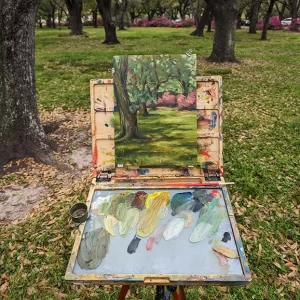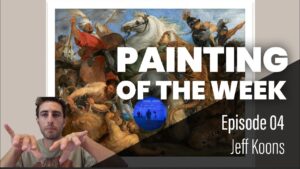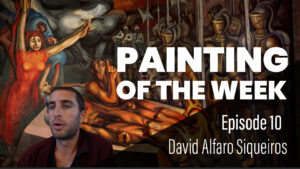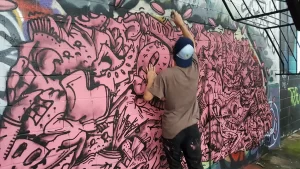A gear-heavy analysis of what goes into a self-supported plein air bicycle mission in Houston, Texas.
Ambitious Beginnings
At the beginning of this year, I decided I would aim to paint 100 plein air paintings here in Houston, Texas. Within the first few weeks, the over-ambitiousness of this project became immediately apparent. To hit 100 plein air paintings, I would need to execute approximately two paintings each week for the entirety of the year.
My (Revised) 2025 Plein Air Ambitions
I decided to scale it back to 50 plein air paintings this year, and that felt more manageable. Simultaneously, I had also set this goal without owning a car. All my Houstonian friends and comrades know this city can be quite challenging, to say the least, without one.
I’m not from here, and for that reason, I still have the stench and entitlement of the East Coast on me, where I grew up not needing or wanting a car, but over time, I’ve had to let that go, adopting the axiom:
“If you can’t beat them, join them.” (aka go into debt)
Nevertheless, innovation comes from limitations. So, with a still ambitious (albeit less ambitious) goal of 50 Houston paintings and no car, I had to improvise to traverse the city.
Without boring you with details: I bought a back rack from Houston Bicycle Co., attached an inordinately large milk crate to it, and voilà. I more or less had enough real estate on the back of my bicycle to schlep the most essential painting supplies.

My Plein Air Painting Kit
My very utilitarian, no-frills plein air kit consists of:
- A very average tripod
- A very not average (in fact, really awesome) easel, or pochade box, made by Ugo Plein Air
I really do love this product. Some years ago, I had initially bought the small size and quickly grew out of it. You’re quite limited in the size of the structure you can paint on, and the palette is very small, at least for an amateur plein air painter like myself, to manage.
All that to say…
I bought a large Ugo Plein Air easel, and I haven’t looked back since.
This piece of equipment fits seamlessly into my backpack alongside:
- Gamblin oil paint
- Brushes (organized in a neat little protective brush carrier)
- Gloves
- Paper towels
- Maybe even a little viewfinder (assuming I don’t forget it in the studio)
Last but Not Least
Let’s say you make a painting you love. I’ll be honest, this happens very infrequently, but if you do accidentally make something good, you need to be able to transport it back home safely.
This is where I got lucky, and the pieces fit together seamlessly.
I have a large plastic bin that my panel, or in this case, my Arches oil paper, fits into. What’s amazing is that this plastic bin fits perfectly into the aggressively large milk crate I described earlier.
This way, once my panel or paper is painted, I can:
- Put it in the bin
- Put the bin in the crate
- Put the backpack with all the painting stuff on top of it
Double voilà.
I’m set up for success in case I need to ride 10 miles back home without damaging my painting.
Plein Air Painting Gear: Check!
We’ve explored the gear and some of the material logistics that go into executing this type of painting mission in Houston.
Now, the somewhat anticlimactic part: I didn’t even end up riding that far to execute this mission.
I happen to live very close to Rice University, so I essentially just rode across the street to the front of the campus (which faces Hermann Park) and painted in the small grouping of woods they have in front of their campus.
A Real H-Town Forest
Despite my proximity to this location, I was quite intimidated to paint such a dense scene. It’s impossible to paint nature tree-for-tree or branch-for-branch in this type of setting. The landscape must be interpreted, and therefore it’s important not to get too lost in the sauce or in the weeds (whatever your preferred metaphor).
Practically speaking, I implement this into my painting practice by making sure I look at my canvas (or in this case, Arches oil paper) more than I look at the scene itself. This is really important. I feel that when artists work from photos, as I have with these portrait painting commissions, they often look at the photo more than the actual painting and thus don’t scrutinize the painting as such.
Fast and Loose
Because I kept the Gamblin paint really thin with Gamsol and painted really loose, I was able to immediately establish an interpretation of the scene, aka, my own painting, as opposed to tethering myself to each detail, which would have made for an absolutely tedious and failed painting.
In the plein air painting video, you can see how my sketch starts very free and loose, as in, there is not one single mistake that could be made (and thats fun!). From there, I started mixing colors freely and blocking in all the white space.
For me, the very first thing I want to do when beginning a painting is:
Remove all white space.
This way, I can start judging the relationships between values and colors against themselves, not against the white of the canvas. If I have lots of white exposed, then every color I put down will look very dark in relation to that bright white, and it will throw off the entire key of the painting.
The Rest Is (Art) History
I blocked in the painting, got rid of all the white space, and tried to interpret the scene as I experienced it while not getting too lost in the paint sauce.
I spent approximately 90 minutes on this painting, ultimately refining and refining until I was happy with the product. Mind you, this is ultimately to live as a sketch, not a finished piece. If I had been in love with the composition (which I wasn’t), I would have taken this piece home and used it as a reference for a larger, more finished work.
However, I didn’t feel too attached to what I created here and was very happy to leave it as a sketch to live in infamy in a notebook that will only be opened about once a year.
Thanks for tuning in, happy plein air painting!





This is so great! Thanks for sharing your process
Thank you!
Pingback: Farewell Houston Graffiti Park, The End of an Era? - Max Lowtide